Key takeaways
- Mindfulness in education fosters emotional resilience, focus, and compassion among students, transforming classroom dynamics.
- Implementing simple techniques like breathing exercises and mindful listening enhances student engagement and emotional awareness.
- Overcoming initial resistance and maintaining consistency are crucial for successful mindfulness integration into daily routines.
- Observing subtle changes in student behavior and emotional language serves as valuable feedback on the impact of mindfulness practices.
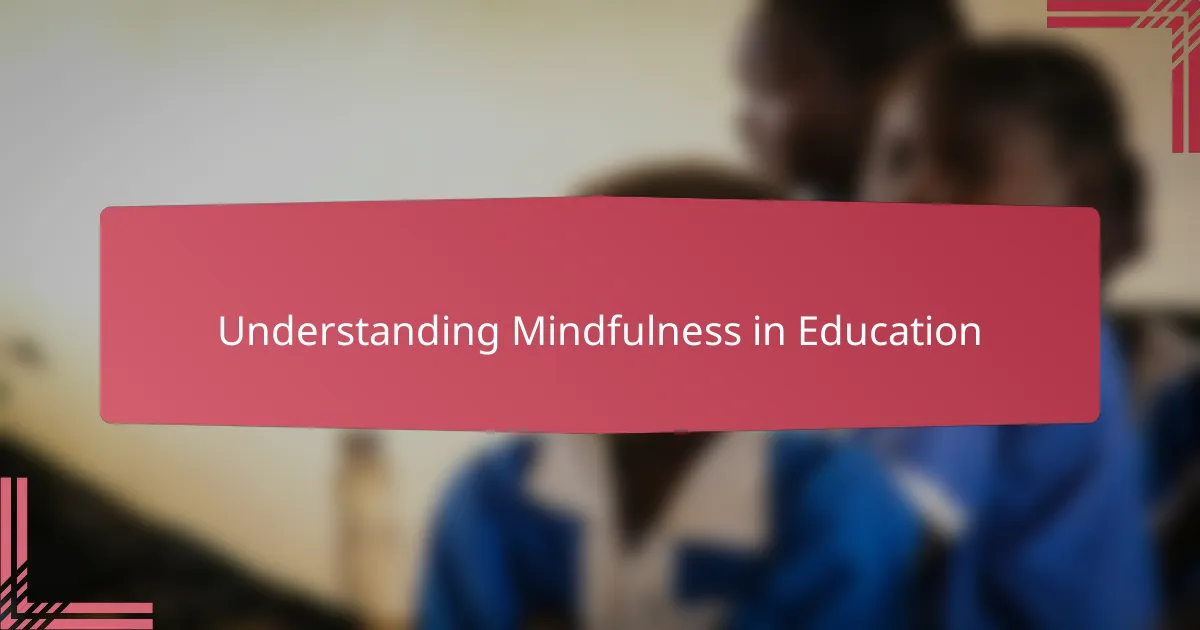
Understanding Mindfulness in Education
Mindfulness in education, to me, is more than just a trendy term; it’s a tool that cultivates awareness and presence in the chaotic rhythm of the classroom. Have you ever noticed how restless a room full of distracted students can feel? Introducing mindfulness shifts that energy, helping both teachers and students anchor themselves in the moment.
When I first started practicing mindfulness with my students, I was surprised by how quickly it created moments of calm and focus. It’s not about perfection or empty silence—rather, it’s a gentle invitation to notice thoughts and feelings without judgment. This approach fosters emotional resilience and a sense of safety that I believe every classroom deserves.
How often do we ask, “Are my students truly here?” Mindfulness answers that by encouraging intentional attention, which strengthens learning and compassion. From my experience, understanding mindfulness as an accessible practice rather than an abstract concept makes all the difference in integrating it authentically in education.
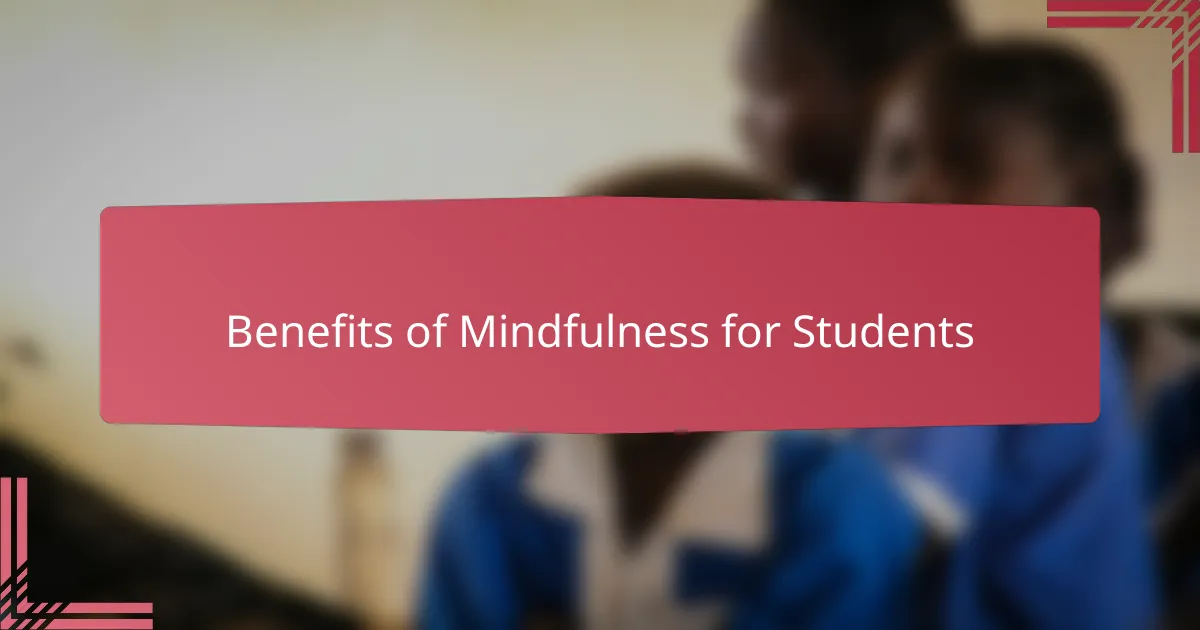
Benefits of Mindfulness for Students
One of the most remarkable benefits I witnessed was how mindfulness helped my students manage their stress. After just a few minutes of guided breathing, I noticed a shift—tense shoulders relaxed, and anxious faces softened. Have you ever seen a child visibly unclench from worry? That moment of calm can open the door to greater focus and emotional balance.
Mindfulness also cultivates empathy in the classroom. When students learn to pause and observe their own feelings, they start to understand others better. I’ve seen kids who struggled with conflict begin to respond with kindness instead of frustration, which transformed the classroom atmosphere in subtle but powerful ways.
What really struck me is how mindfulness supports academic growth by strengthening attention. Instead of rushing through lessons, students become curious and engaged participants. It feels like unlocking a hidden resource—when students are present, learning happens more naturally and deeply, and the classroom becomes a vibrant community of thinkers.

Essential Mindfulness Techniques for Classrooms
One technique that I found essential was starting each class with a simple breathing exercise. I remember one morning when a usually fidgety student took a deep breath alongside the rest of the class and stayed quiet for a full minute—it was like the whole room collectively slowed down. Have you ever tried just focusing on your breath and felt your tension ease? That small pause can reset the entire classroom energy.
Another practice I integrated involved “mindful listening” where students pair up and really tune into what their partner is sharing without interrupting. At first, it felt almost awkward, but soon I noticed the conversations deepened, and the kids became more patient and present with each other. It was a powerful reminder that mindfulness isn’t just about quiet—it’s also about genuinely connecting.
Occasionally, I led short body scans, guiding students to notice sensations from their toes to their heads. I was amazed at how this helped kids become aware of stress and release it in real time. Do you realize how often we move through the day without checking in with ourselves? Regularly bringing attention back to the body can ground students and improve their readiness to learn.
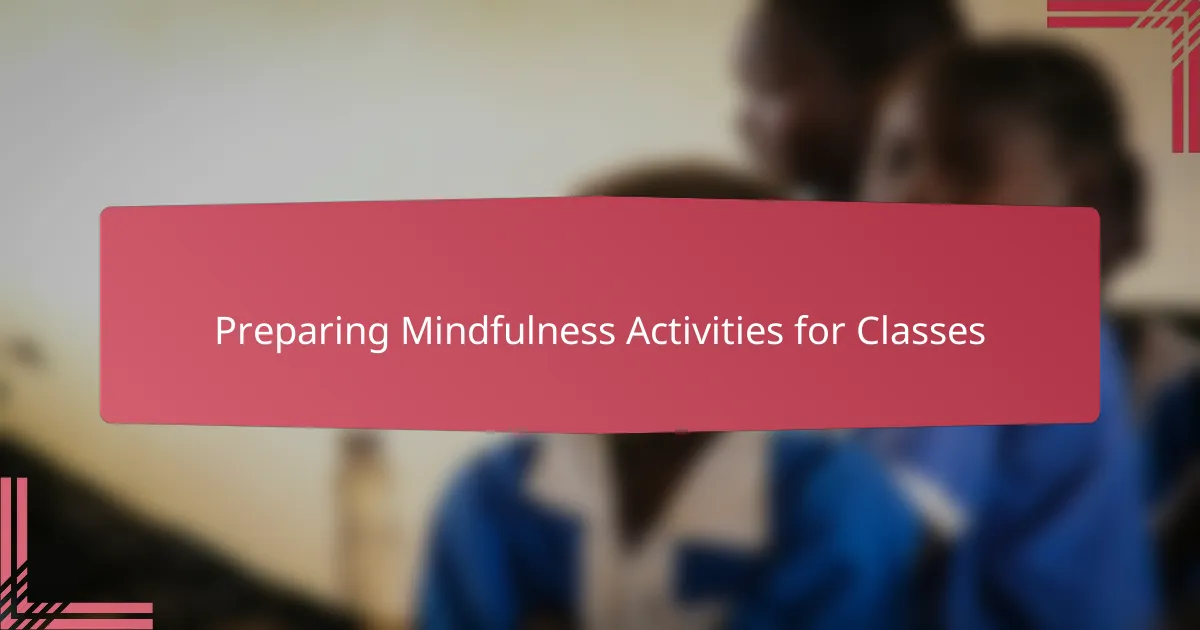
Preparing Mindfulness Activities for Classes
Preparing mindfulness activities for my classes always starts with considering what will genuinely resonate with the students. I remember preparing a simple guided breathing session, and I wondered, “Will this feel too forced or awkward for them?” To my relief, it became a calm anchor that students actually looked forward to.
I like to mix things up so mindfulness doesn’t lose its freshness. Sometimes I create short story prompts that invite kids to imagine peaceful places or experiences, which helps their minds settle. Have you ever noticed how a little imagination can gently pull you out of a stressful moment? Incorporating creativity this way makes mindfulness feel more inviting.
Another key to preparation is keeping the timing flexible. I found that starting with just a minute or two allows students to ease in without pressure. Over time, these brief practices built a habit of presence that felt natural rather than extra work—a quiet rhythm woven into our busy days.
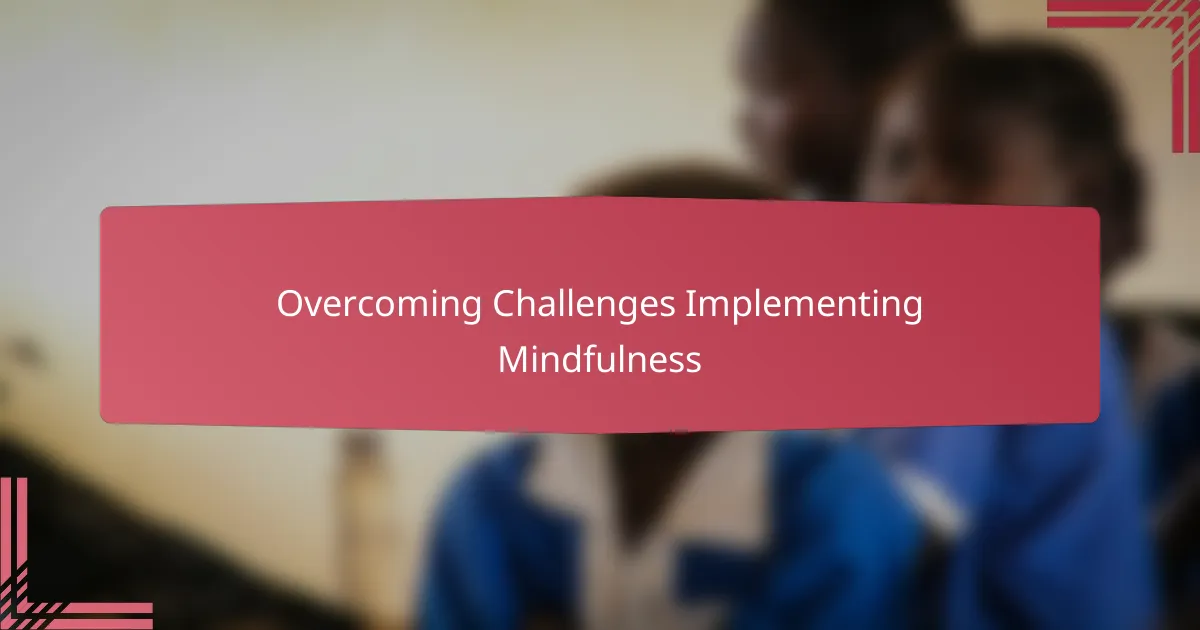
Overcoming Challenges Implementing Mindfulness
One challenge I faced was initial resistance—some students (and honestly, a few colleagues) viewed mindfulness as “just sitting quietly,” which felt unproductive to them. I learned that framing mindfulness as a skill for managing real classroom stress, rather than a passive activity, helped shift that mindset and open doors to participation.
Another tricky part was consistency. With everything going on in a typical school day, it was easy to skip or rush mindfulness moments. I started using natural transitions—like the moment after recess or settling in from lunch—to anchor these practices. Have you tried folding mindfulness into routines? That little adjustment made it feel less like an added task and more like a rhythm.
Sometimes, I struggled with my own hesitation, wondering if I was doing mindfulness “right.” Remembering that it’s not about perfection but presence eased that pressure. I found that embracing the imperfect moments alongside my students built trust and showed them mindfulness is a practice, not a performance.
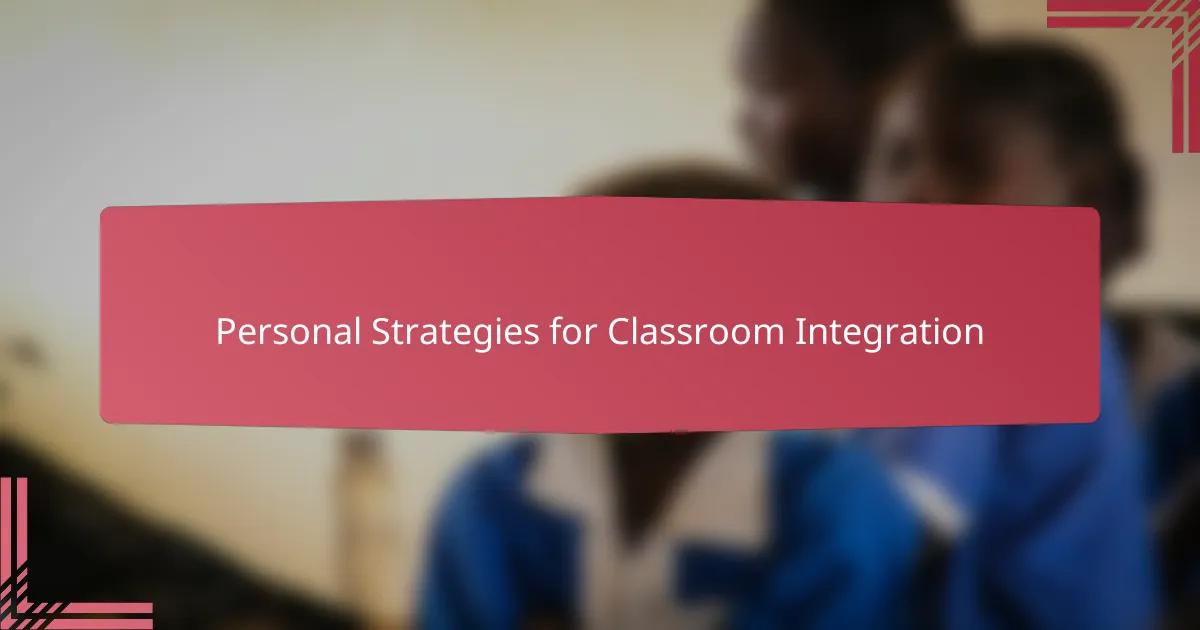
Personal Strategies for Classroom Integration
When I first brought mindfulness into my classroom, I realized I had to find personal ways to make it fit naturally into our daily flow. I started by tuning into my own moments of stress, using brief breathing pauses between lessons, which made it easier to guide my students authentically. Have you ever thought about how your own calm can set the tone for the whole room? That became a small but powerful strategy for me.
I also discovered that adaptability was key—I didn’t stick to rigid scripts but adjusted each mindfulness moment based on the mood and energy I sensed in the class. Some days, we’d share a quiet reflection; other times, a short mindful stretch. This flexibility helped the practice feel less like a task and more like a shared experience, building a subtle but meaningful connection with my students.
Another personal trick was inviting students to create their own mindfulness cues—simple actions or words they could use when feeling overwhelmed. Watching them take ownership of their calm moments filled me with hope and reminded me that mindfulness thrives when it’s personalized. Isn’t it amazing how small personalized habits can ripple into lasting change in the classroom?
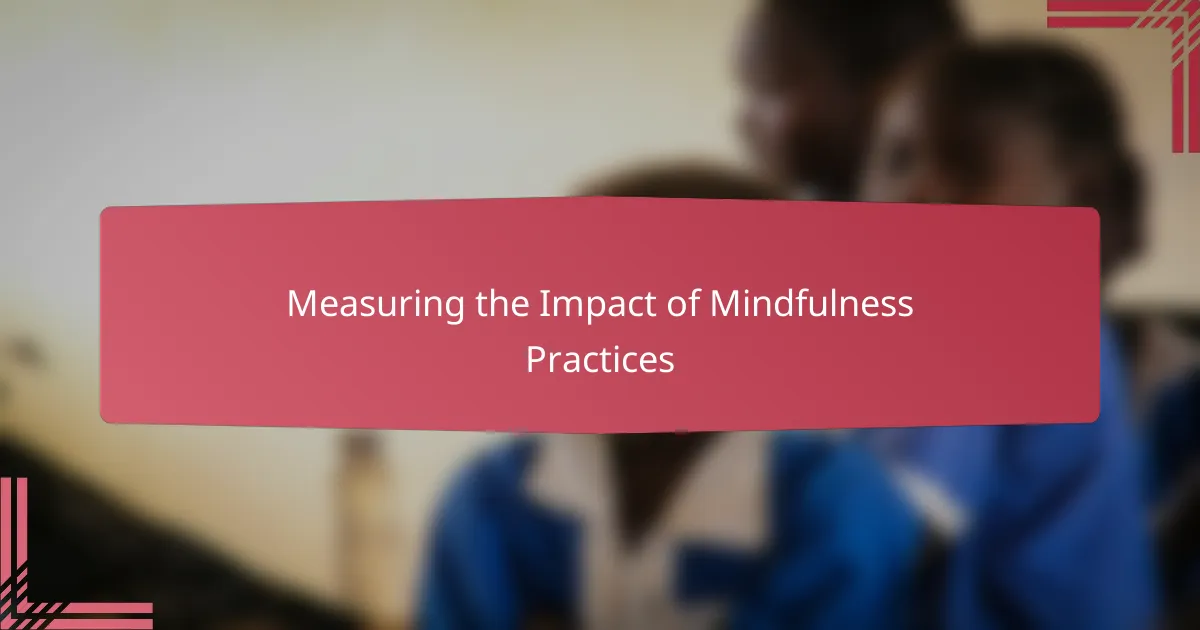
Measuring the Impact of Mindfulness Practices
Measuring the impact of mindfulness in my classroom wasn’t something I planned from the start, but I quickly realized that observing subtle shifts was a powerful form of feedback. Have you ever noticed how a student who used to fidget incessantly suddenly sits a little taller, or how a tense moment dissolves into calm after a brief breathing exercise? Those small, observable changes told me more than any formal test ever could.
I also used reflective conversations to gauge impact, asking students how they felt before and after mindfulness practices. Their honest replies—sometimes shy, sometimes enthusiastic—revealed an emotional language developing around self-awareness. It made me appreciate that impact isn’t just about grades or behavior charts; it’s about cultivating a new kind of emotional literacy that quietly transforms the classroom culture.
Quantifying mindfulness benefits can be tricky, but I found that consistency over time produced clearer patterns. When I tracked moments of focused attention or noticed fewer conflicts, I knew the practice was rooting itself in their daily lives. Isn’t that the real goal—helping students carry calm and presence beyond the classroom walls? That kind of lasting impact feels both subtle and profound, and it continually motivates me to keep refining my approach.